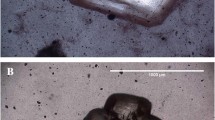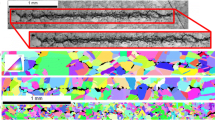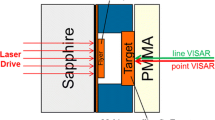Abstract
Crystals of energetic materials, such as 1,3,5,7-Tetranitro-1,3,5,7-tetrazocane (HMX), embedded in plastic binders are the building blocks of plastic-bonded explosives (PBX). Such heterogeneous energetic materials contain microstructural features such as sharp corners, interfaces between crystal and binder, intra- and extra-granular voids, and other defects. Energy localization or “hotspots” arise during shock interaction with the microstructural heterogeneities, leading to initiation of PBXs. In this paper, high-resolution numerical simulations are performed to elucidate the mechanistic details of shock-induced initiation in a PBX; we examine four different mechanisms: (1) shock-focusing at sharp corners or edges and its dependency on the shape of the crystal and the strength of the applied shock; (2) debonding between crystal and binder interfaces; (3) collapse of voids in the binder located near an HMX crystal; and (4) the collapse of voids within HMX crystals. Insights are obtained into the relative contributions of these mechanisms to the ignition and growth of hotspots. Understanding these mechanisms of energy localization and their relative importance for hotspot formation and initiation sensitivity of PBXs will aid in the design of energetic material-driven systems with controlled sensitivity, to prevent accidental initiation and ensure reliable performance.


















Similar content being viewed by others
Data Availability Statement
The datasets generated during and/or analysed during the current study are available from the corresponding author on reasonable request.
References
Yan, Q.-L., Zeman, S., Elbeih, A.: Recent advances in thermal analysis and stability evaluation of insensitive plastic bonded explosives (PBXs). Thermochim. Acta 537, 1–12 (2012). https://doi.org/10.1016/j.tca.2012.03.009
Campbell, A.W., Davis, W.C., Ramsay, J.B., Travis, J.R.: Shock initiation of solid explosives. Phys. Fluids 4, 511–521 (1961). https://doi.org/10.1063/1.1706354
Menikoff, R.: Granular explosives and initiation sensitivity. LA-UR-99-6023 (1999). http://lib-www.lanl.gov/la-pubs/00796456.pdf
Menikoff, R.: Pore collapse and hot spots in HMX. AIP Conference Proceedings 706, 393–396 (2004). https://doi.org/10.1063/1.1780261
Lee, E.L., Tarver, C.M.: Phenomenological model of shock initiation in heterogeneous explosives. Phys. Fluids 23, 2362 (1980). https://doi.org/10.1063/1.862940
Tarver, C.M., Chidester, S.K., Nichols, A.L.: Critical conditions for impact- and shock-induced hot spots in solid explosives. J. Phys. Chem. 100, 5794–5799 (1996). https://doi.org/10.1021/jp953123s
Handley, C.A.: Critical hotspots and flame propagation in HMX-based explosives. AIP Conference Proceedings 1426, 283–286 (2012). https://doi.org/10.1063/1.3686274
Hu, Y., Brenner, D.W., Shi, Y.: Detonation initiation from spontaneous hotspots formed during cook-off observed in molecular dynamics simulations. J. Phys. Chem. C 115, 2416–2422 (2011). https://doi.org/10.1021/jp109583g
Zhang, J., Jackson, T.L.: Direct detonation initiation with thermal deposition due to pore collapse in energetic materials—towards the coupling between micro- and macroscale. Combust. Theory Model. 21, 248–273 (2017). https://doi.org/10.1080/13647830.2016.1218053
Johnson, B.P., Zhou, X., Ihara, H., Dlott, D.D.: Observing hot spot formation in individual explosive crystals under shock compression. J. Phys. Chem. A 124, 4646–4653 (2020). https://doi.org/10.1021/acs.jpca.0c02788
Yeager, J.D., Luo, S.N., Jensen, B.J., Fezzaa, K., Montgomery, D.S., Hooks, D.E.: High-speed synchrotron X-ray phase contrast imaging for analysis of low-Z composite microstructure. Compos. Part A Appl. Sci. Manuf. 43, 885–892 (2012). https://doi.org/10.1016/j.compositesa.2012.01.013
Mang, J.T.: An optical microscopy and small-angle scattering study of porosity in thermally treated PBX 9501. AIP Conference Proceedings 820, 833–836 (2002). https://doi.org/10.1063/1.1483666
Palmer, S.J.P., Field, J.E., Huntely, J.M.: Deformation, strengths and strains to failure of polymer bonded explosives. Proc. R. Soc. Lond. A. 440, 399–419 (1993). https://doi.org/10.1098/rspa.1993.0023
van der Heijden, A.E.D.M., Bouma, R.H.B.: Crystallization and characterization of RDX, HMX, and CL-20. Cryst. Growth Design 4, 999–1007 (2004). https://doi.org/10.1021/cg049965a
Campbell, A.W., Davis, W.C., Ramsay, J.B., Travis, J.R.: Shock initiation of solid explosives. Phys. Fluids 4, 511–521 (1961). https://doi.org/10.1063/1.1706354
Baer, M.R.: Modeling heterogeneous energetic materials at the mesoscale. Thermochim. Acta 384, 351–367 (2002). https://doi.org/10.1016/S0040-6031(01)00794-8
Lee Perry, W., Clements, B., Ma, X., Mang, J.T.: Relating microstructure, temperature, and chemistry to explosive ignition and shock sensitivity. Combust. Flame 190, 171–176 (2018). https://doi.org/10.1016/j.combustflame.2017.11.017
Bassett, W.P., Johnson, B.P., Salvati, L., Dlott, D.D.: Pyrometry in the reaction zone of PETN- and RDX-based polymer bound explosives. AIP Conference Proceedings 2272, 030002 (2020). https://doi.org/10.1063/12.0000912
Roberts, Z.A., Casey, A.D., Gunduz, I.E., Rhoads, J.F., Son, S.F.: The effects of crystal proximity and crystal-binder adhesion on the thermal responses of ultrasonically-excited composite energetic materials. J. Appl. Phys. 122, 244901 (2017). https://doi.org/10.1063/1.5005896
Men, Z., Suslick, K.S., Dlott, D.D.: Thermal explosions of polymer-bonded explosives with high time and space resolution. J. Phys. Chem. C. 122, 14289–14295 (2018). https://doi.org/10.1021/acs.jpcc.8b02422
Fujisawa, K., Jackson, T.L., Balachandar, S.: Influence of baroclinic vorticity production on unsteady drag coefficient in shock-particle interaction. J. Appl. Phys. 125, 084901 (2019). https://doi.org/10.1063/1.5055002
Kim, S., Wei, Y., Horie, Y., Zhou, M.: Prediction of shock initiation thresholds and ignition probability of polymer-bonded explosives using mesoscale simulations. J. Mech. Phys. Solids 114, 97–116 (2018). https://doi.org/10.1016/j.jmps.2018.02.010
Springer, H.K., Bastea, S., Nichols, A.L., Tarver, C.M., Reaugh, J.E.: Modeling the effects of shock pressure and pore morphology on hot spot mechanisms in HMX. Propellants Explos. Pyrotech. 43, 805–817 (2018). https://doi.org/10.1002/prep.201800082
Gilbert, J., Chakravarthy, S., Gonthier, K.A.: Computational analysis of hot-spot formation by quasi-steady deformation waves in porous explosive. J. Appl. Phys. 113, 194901 (2013). https://doi.org/10.1063/1.4804932
Chakravarthy, S., Gonthier, K.A., Panchadhara, R.: Analysis of mesoscale heating by piston supported waves in granular metalized explosive. Model. Simul. Mater. Sci. Eng. 21, 055016 (2013). https://doi.org/10.1088/0965-0393/21/5/055016
Kapahi, A., Udaykumar, H.S.: Dynamics of void collapse in shocked energetic materials: physics of void-void interactions. Shock Waves 23, 537–558 (2013). https://doi.org/10.1007/s00193-013-0439-6
Michael, L., Nikiforakis, N.: The evolution of the temperature field during cavity collapse in liquid nitromethane. Part I: inert case. Shock Waves 29, 153–172 (2019). https://doi.org/10.1007/s00193-018-0802-8
Mi, X.C., Michael, L., Ioannou, E., Nikiforakis, N., Higgins, A.J., Ng, H.D.: Meso-resolved simulations of shock-to-detonation transition in nitromethane with air-filled cavities. J. Appl. Phys. 125, 245901 (2019). https://doi.org/10.1063/1.5093990
Springer, H.K., Tarver, C.M., Bastea, S.: Effects of high shock pressures and pore morphology on hot spot mechanisms in HMX. AIP Conference Proceedings 1793, 080002 (2017). https://doi.org/10.1063/1.4971608
Rai, N.K., Udaykumar, H.S.: Three-dimensional simulations of void collapse in energetic materials. Phys. Rev. Fluids 3, 033201 (2018). https://doi.org/10.1103/PhysRevFluids.3.033201
Gonthier, K.A.: Modeling and analysis of reactive compaction for granular energetic solids. Combust. Sci. Technol. 175, 1679–1709 (2003). https://doi.org/10.1080/00102200302373
Rai, N.K., Udaykumar, H.S.: Mesoscale simulation of reactive pressed energetic materials under shock loading. J. Appl. Phys. 118, 245905 (2015). https://doi.org/10.1063/1.4938581
Zhao, P., Lee, S., Sewell, T., Udaykumar, H.S.: Tandem molecular dynamics and continuum studies of shock-induced pore collapse in TATB. Propellants Explos. Pyrotech. 45, 196–222 (2020). https://doi.org/10.1002/prep.201900382
Rai, N.K., Schmidt, M.J., Udaykumar, H.S.: Collapse of elongated voids in porous energetic materials: effects of void orientation and aspect ratio on initiation. Phys. Rev. Fluids 2, 043201 (2017). https://doi.org/10.1103/PhysRevFluids.2.043201
Rai, N.K., Schmidt, M.J., Udaykumar, H.S.: High-resolution simulations of cylindrical void collapse in energetic materials: effect of primary and secondary collapse on initiation thresholds. Phys. Rev. Fluids 2, 043202 (2017). https://doi.org/10.1103/PhysRevFluids.2.043202
Das, P., Zhao, P., Perera, D., Sewell, T., Udaykumar, H.S.: Molecular dynamics-guided material model for the simulation of shock-induced pore collapse in \(\beta \)-octahydro-1,3,5,7-tetranitro-1,3,5,7-tetrazocine (\(\beta \)-HMX). J. Appl. Phys. 130, 085901 (2021). https://doi.org/10.1063/5.0056560
Rai, N.K., Escauriza, E.M., Eakins, D.E., Udaykumar, H.S.: Mechanics of shock induced pore collapse in poly(methyl methacrylate) (PMMA): comparison of simulations and experiments. J. Mech. Phys. Solids 143, 104075 (2020). https://doi.org/10.1016/j.jmps.2020.104075
An, Q., Goddard, W.A., Zybin, S.V., Jaramillo-Botero, A., Zhou, T.: Highly shocked polymer bonded explosives at a nonplanar interface: hot-spot formation leading to detonation. J. Phys. Chem. C 117, 26551–26561 (2013). https://doi.org/10.1021/jp404753v
An, Q., Goddard, W.A., Zybin, S.V., Luo, S.-N.: Inhibition of hotspot formation in polymer bonded explosives using an interface matching low density polymer coating at the polymer-explosive Interface. J. Phys. Chem. C 118, 19918–19928 (2014). https://doi.org/10.1021/jp506501r
Wang, C., Eliasson, V.: Shock wave focusing in water inside convergent structures. Int. J. Multiphys. 3, 267–281 (2012). https://doi.org/10.1260/1750-9548.6.3.267
Sambasivan, S., Kapahi, A., Udaykumar, H.S.: Simulation of high speed impact, penetration and fragmentation problems on locally refined Cartesian grids. J. Comput. Phys. 235, 334–370 (2013). https://doi.org/10.1016/j.jcp.2012.10.031
Kapahi, A., Mousel, J., Sambasivan, S., Udaykumar, H.S.: Parallel, sharp interface Eulerian approach to high-speed multi-material flows. Comput. Fluids 83, 144–156 (2013). https://doi.org/10.1016/j.compfluid.2012.06.024
Kapahi, A., Sambasivan, S., Udaykumar, H.S.: A three-dimensional sharp interface Cartesian grid method for solving high speed multi-material impact, penetration and fragmentation problems. J. Comput. Phys. 241, 308–332 (2013). https://doi.org/10.1016/j.jcp.2013.01.007
Dillard, S.I., Mousel, J.A., Shrestha, L., Raghavan, M.L., Vigmostad, S.C.: From medical images to flow computations without user-generated meshes. Int. J. Numer. Methods Biomed. Eng. 30, 1057–1083 (2014). https://doi.org/10.1002/cnm.2644
Sethian, J.A., Smereka, P.: Level set methods for fluid interfaces. Annu. Rev. Fluid Mech. 35, 341–372 (2003). https://doi.org/10.1146/annurev.fluid.35.101101.161105
Das, P., Rai, N.K., Udaykumar, H.S.: A levelset-based sharp-interface modified ghost fluid method for high-speed multiphase flows and multi-material hypervelocity impact. In: Roy, S., De, A., Balaras, E. (eds.) Immersed Boundary Method: Development and Applications, pp. 187–226. Springer, Singapore (2020)
Das, P., Udaykumar, H.S.: A sharp-interface method for the simulation of shock-induced vaporization of droplets. J. Comput. Phys. 405, 109005 (2020). https://doi.org/10.1016/j.jcp.2019.109005
de Brauer, A., Rai, N.K., Nixon, M.E., Udaykumar, H.S.: Modeling impact-induced damage and debonding using level sets in a sharp interface Eulerian framework. Int. J. Numer. Methods Eng. 115, 1108–1137 (2018). https://doi.org/10.1002/nme.5837
Nassar, A., Rai, N.K., Sen, O., Udaykumar, H.S.: Modeling mesoscale energy localization in shocked HMX, part I: machine-learned surrogate models for the effects of loading and void sizes. Shock Waves 29, 537–558 (2019). https://doi.org/10.1007/s00193-018-0874-5
Kroonblawd, M.P., Austin, R.A.: Sensitivity of pore collapse heating to the melting temperature and shear viscosity of HMX. Mech. Mater. 152, 103644 (2021). https://doi.org/10.1016/j.mechmat.2020.103644
Sambasivan, S.K.: A sharp interface cartesian grid hydrocode. Doctoral Dissertation, The University of Iowa (2010). https://doi.org/10.17077/etd.b55egfyg
Simo, J.C., Hughes, T.J.R.: General return mapping algorithms for rate-independent plasticity. In: Constitutive Laws for Engineering Materials: Theory and Applications, pp. 221–232. Elsevier, New York (1987)
Menikoff, R., Sewell, T.D.: Constituent properties of HMX needed for mesoscale simulations. Combust. Theory Model. 6, 103–125 (2002). https://doi.org/10.1088/1364-7830/6/1/306
Sewell, T.D., Menikoff, R.: Complete equation of state for \(\beta \)-HMX and implications for initiation. AIP Conference Proceedings 706, 157–162 (2004). https://doi.org/10.1063/1.1780207
Yoo, C., Cynn, H., Introduction, I.: Equation of state, phase transition, decomposition of \(\beta \)-HMX (octahydro-1,3,5,7- tetranitro-1,3,5,7-tetrazocine) at high pressures). J. Chem. Phys. 111, 10229–10235 (1999)
John, E.F.: Hot spot ignition mechanisms for explosives. Acc. Chem. Res. 25, 489–496 (1992). https://doi.org/10.1021/ar00023a002
Stevens, L.L., Velisavljevic, N., Hooks, D.E., Dattelbaum, D.M.: Hydrostatic compression curve for triamino-trinitrobenzene determined to 13.0 GPa with powder X-ray diffraction. Propellants Explos. Pyrotechn. 33, 286–295 (2008). https://doi.org/10.1002/prep.200700270
Wescott, B.L., Stewart, D.S., Davis, W.C.: Equation of state and reaction rate for condensed-phase explosives. J. Appl. Phys. 98, 053514 (2005). https://doi.org/10.1063/1.2035310
Najjar, F.M., Howard, W.M., Fried, L.E.: Grain-scale simulations of hot-spot initiation for shocked TATB. AIP Conference Proceedings 1195, pp. 49–52 (2009). https://doi.org/10.1063/1.3295184
Mas, E.M., Clements, B.E., Blumenthal, B., Cady, C.M., Gray, G.T., Liu, C.: A viscoelastic model for PBX binders. AIP Conference Proceedings 620, 661–664 (2002). https://doi.org/10.1063/1.1483625
Sun, Q., Hossack, J.A., Tang, J., Acton, S.T.: Speckle reducing anisotropic diffusion for 3D ultrasound images. Comput. Med. Imaging Graph. 28, 461–470 (2004). https://doi.org/10.1016/j.compmedimag.2004.08.001
Chan, T.F., Vese, L.A.: Active contours without edges. IEEE Trans. Image Process. 10, 266–277 (2001). https://doi.org/10.1109/83.902291
Sambasivan, S.K., Udaykumar, H.S.: Sharp interface simulations with Local Mesh Refinement for multi-material dynamics in strongly shocked flows. Comput. Fluids 39, 1456–1479 (2010). https://doi.org/10.1016/j.compfluid.2010.04.014
Fedkiw, R.P., Aslam, T., Merriman, B., Osher, S.: A non-oscillatory Eulerian approach to interfaces in multimaterial flows (the Ghost Fluid Method). J. Comput. Phys. 152, 457–492 (1999). https://doi.org/10.1006/jcph.1999.6236
Shu, C.-W., Osher, S.: Efficient implementation of essentially non-oscillatory shock-capturing schemes. II. J. Comput. Phys. 83, 32–78 (1989). https://doi.org/10.1016/0021-9991(89)90222-2
Gottlieb, S., Shu, C.-W.: Total variation diminishing Runge–Kutta schemes. Math. Comput. 67, 73–85 (1998). https://doi.org/10.1090/S0025-5718-98-00913-2
Rai, N.K.: Numerical framework for mesoscale simulation of heterogeneous energetic materials. PhD Thesis, University of Iowa (2015). https://doi.org/10.17077/etd.tiq54x33
Skidmore, C.B., Phillips, D.S., Son, S.F., Asay, B.W.: Characterization of HMX particles in PBX 9501. AIP Conference Proceedings 429, 579–582 (1998). https://doi.org/10.1063/1.55666
Acknowledgements
This work was supported by an AFOSR-MURI Grant (Grant No.: FA9550-19-1-0318; program manager: Martin Schmidt). The authors acknowledge illuminating discussions with Dana D. Dlott (Department of Chemistry, University of Illinois Urbana-Champaign), Xuan Zhou (Department of Chemistry, University of Illinois Urbana-Champaign), and Belinda P. Johnson (Department of Chemistry, University of Illinois Urbana-Champaign). The authors would like to thank Xuan Zhou (Department of Chemistry, University of Illinois Urbana-Champaign) for providing the high-resolution CT image of the HMX crystal in binder used for numerical simulations in this work.
Author information
Authors and Affiliations
Corresponding author
Additional information
Communicated by D. Frost.
Publisher's Note
Springer Nature remains neutral with regard to jurisdictional claims in published maps and institutional affiliations.
Rights and permissions
Springer Nature or its licensor holds exclusive rights to this article under a publishing agreement with the author(s) or other rightsholder(s); author self-archiving of the accepted manuscript version of this article is solely governed by the terms of such publishing agreement and applicable law.
About this article
Cite this article
Das, P., Udaykumar, H.S. Mechanisms of shock-induced initiation at micro-scale defects in energetic crystal-binder systems. Shock Waves 32, 593–616 (2022). https://doi.org/10.1007/s00193-022-01099-x
Received:
Accepted:
Published:
Issue Date:
DOI: https://doi.org/10.1007/s00193-022-01099-x




